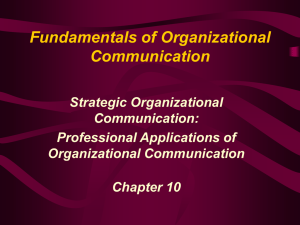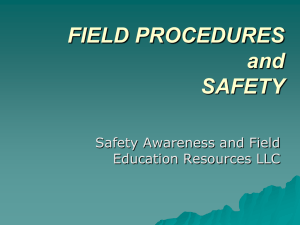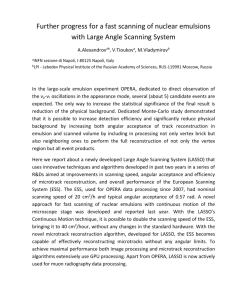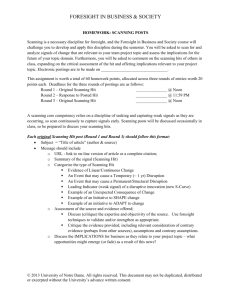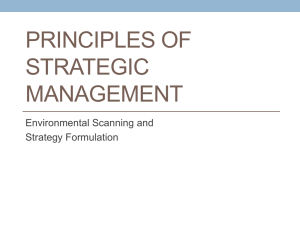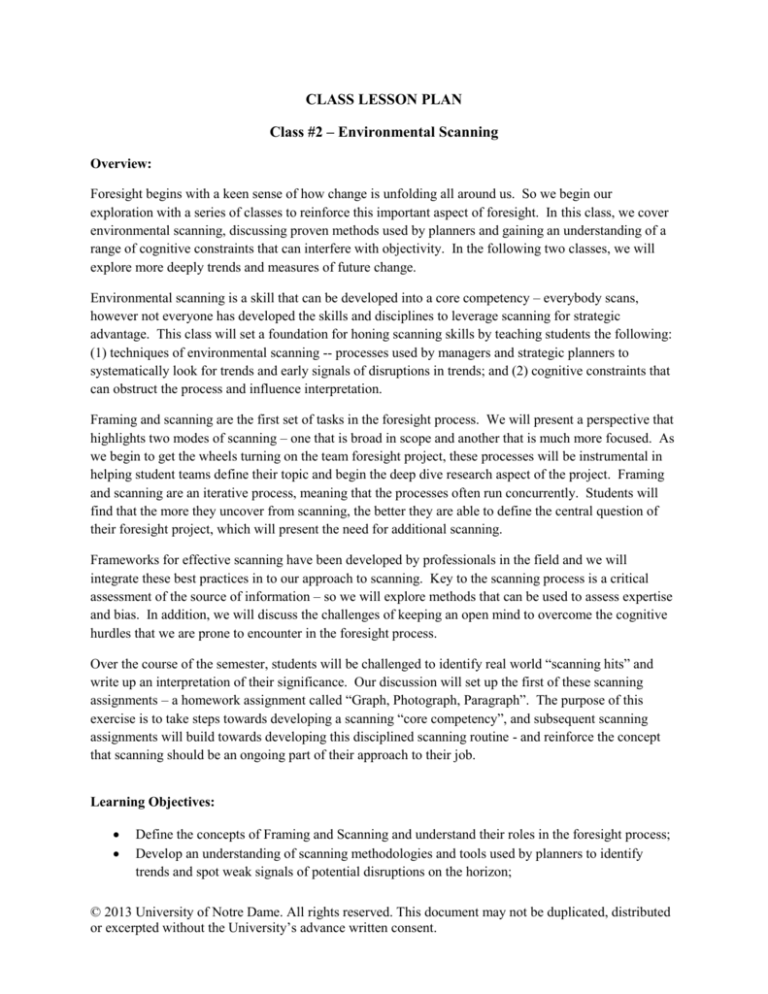
CLASS LESSON PLAN
Class #2 – Environmental Scanning
Overview:
Foresight begins with a keen sense of how change is unfolding all around us. So we begin our
exploration with a series of classes to reinforce this important aspect of foresight. In this class, we cover
environmental scanning, discussing proven methods used by planners and gaining an understanding of a
range of cognitive constraints that can interfere with objectivity. In the following two classes, we will
explore more deeply trends and measures of future change.
Environmental scanning is a skill that can be developed into a core competency – everybody scans,
however not everyone has developed the skills and disciplines to leverage scanning for strategic
advantage. This class will set a foundation for honing scanning skills by teaching students the following:
(1) techniques of environmental scanning -- processes used by managers and strategic planners to
systematically look for trends and early signals of disruptions in trends; and (2) cognitive constraints that
can obstruct the process and influence interpretation.
Framing and scanning are the first set of tasks in the foresight process. We will present a perspective that
highlights two modes of scanning – one that is broad in scope and another that is much more focused. As
we begin to get the wheels turning on the team foresight project, these processes will be instrumental in
helping student teams define their topic and begin the deep dive research aspect of the project. Framing
and scanning are an iterative process, meaning that the processes often run concurrently. Students will
find that the more they uncover from scanning, the better they are able to define the central question of
their foresight project, which will present the need for additional scanning.
Frameworks for effective scanning have been developed by professionals in the field and we will
integrate these best practices in to our approach to scanning. Key to the scanning process is a critical
assessment of the source of information – so we will explore methods that can be used to assess expertise
and bias. In addition, we will discuss the challenges of keeping an open mind to overcome the cognitive
hurdles that we are prone to encounter in the foresight process.
Over the course of the semester, students will be challenged to identify real world “scanning hits” and
write up an interpretation of their significance. Our discussion will set up the first of these scanning
assignments – a homework assignment called “Graph, Photograph, Paragraph”. The purpose of this
exercise is to take steps towards developing a scanning “core competency”, and subsequent scanning
assignments will build towards developing this disciplined scanning routine - and reinforce the concept
that scanning should be an ongoing part of their approach to their job.
Learning Objectives:
Define the concepts of Framing and Scanning and understand their roles in the foresight process;
Develop an understanding of scanning methodologies and tools used by planners to identify
trends and spot weak signals of potential disruptions on the horizon;
© 2013 University of Notre Dame. All rights reserved. This document may not be duplicated, distributed
or excerpted without the University’s advance written consent.
Understand the cognitive pitfalls that hinder interpretation in the scanning process and develop an
awareness of how to manage them;
Introduce the first in a series of scanning assignments and begin the process of gaining hands on
experience scanning for and interpreting signals of change.
Key Terms and Concepts:
Environmental Scanning (Radar)
Deep Dives (Research)
Framing
DEGEST / STEEP
Weak Signals
“Diamonds in the Rough”
Cross Impact Analysis
Peripheral Vision
Cognitive Constraints
Selective Perception
Educated Incapacity
Affinity Bias (Anchoring)
Confirmation Bias
Availability Bias
Alien Eyes
Figure-Ground
Class Preparation:
Readings:
FutureThink, Part 1, Pages 1-21 by Edie Weiner and Arnold Brown (2006)
Discussion Questions:
What is “educated incapacity” and how does it relate to foresight?
What strategies can be used to overcome educated incapacity and other cognitive biases?
Describe the Figure-Ground concept and explain its relevance to scanners.
You are likely familiar with the term “peripheral vision”. How might this concept be relevant to
business leaders as they look to lead their organizations into the future?
When scanning, it is suggested that scanners explore unfamiliar and uninteresting areas? Given
the explosion of available evidence, why do you suppose this would be seen as a productive use
of time?
Assignment Due:
Graph, Paragraph, Photograph assignment due by ___________________________________.
Be prepared to briefly discuss your observation in Class 3.
© 2013 University of Notre Dame. All rights reserved. This document may not be duplicated, distributed
or excerpted without the University’s advance written consent.
INTRUCTOR GUIDELINES
Discussion Launchers:
Is change accelerating?
Ask students on what basis would they answer this question.
What evidence might they gather to support their perspective?
Discussion Questions w/ Answers:
Do you agree that the world is experiencing rapid change? Do you think it is accelerating?
On what evidence do you base your answer?
A: Most students will argue that the pace of change is accelerating. Challenge them on the
continuity of those aspects that remain largely the same as they were a decade or more ago.
For example, the work week is still roughly the same as it has been for decades, even though
productivity tools are ubiquitous. Nationalism and the resulting complications of national
conflict are basically the same as they have been even though new communication and
surveillance technologies have been dramatically improved. Use this question as a
discussion launcher to get the session rolling.
What is “educated incapacity” and how does it relate to foresight?
A: Educated incapacity occurs when someone has too much information to see clearly – i.e.
they carry a bias (conscious or unconscious) that inhibits their perspective on the matter.
What strategies can be used to overcome educated incapacity and other cognitive biases?
A:
o Consider new and contradictory information
o Challenge your own beliefs
See the world through “Alien Eyes”
o Challenge the assumptions and conclusions
o Involve others (e.g. Crowd Sourcing)
o Defer judgment
Describe the Figure-Ground concept and explain its relevance to scanners.
A: The Figure-Ground concept is all about focus and its effect on perspective. For example,
using the window/kite example conducted by Edie Weiner, half of a group had a mental focus
on a kite and the other had a mental focus on a flower in front of a window. Based on this
mental focus, their interpretation of the image fell firmly into two perspectives.
Business leaders sometimes get accustomed to their particular worldview and in doing so
treat important aspects of the environment as background. By overcoming this perceptual
constraint, innovators and business leaders can open a whole new lens of opportunity.
Examples include male/female and youth/aging. See FutureThink for elaboration.
© 2013 University of Notre Dame. All rights reserved. This document may not be duplicated, distributed
or excerpted without the University’s advance written consent.
For scanners, this is important because our perceived focus on the “figure” may interfere
with our understanding and awareness of the broader picture. Scanners need to keep an
open mind and develop the capability to invert figure and ground to open their perception of
broader possibilities.
You are likely familiar with the term “peripheral vision”. How might this concept be relevant
to business leaders as they look to lead their organizations into the future?
A: Companies too often develop tunnel vision in regard to seeking information from the
environment. Peripheral vision is key to not being blindsided, however it requires that we
look to novel places for signals of change. The periphery is where interesting change is
occurring. Managing the volume of available information is a big challenge so that scanners
do not get bogged down with sources and signals that lack relevance. This is why framing
and scanning are considered an iterative process.
When scanning, it is suggested that scanners explore unfamiliar and uninteresting areas?
Given the existence of way too much evidence, why do you suppose this would be seen as a
productive use of time?
A: Stepping outside the box can create a new flow of information and the value of this
information is often much greater than any cost incurred. Business usually over estimates the
cost of this type of scanning – an occasional unique conference for example. Bishop suggests
that it is best to start slowly, scanning new magazines for example and build from there to not
get too far astray.
Class Timeline:
2 Minutes – Quote of the Day and Intro
10 Minutes – Overview of Scanning and Framing
5 Minute – Adopting a Global Perspective
20 Minutes – Scanning the Environment – Class exercise
o 10 Minutes – Exploration of Foresight Scanning Resources website
o 10 Minutes – Discussion
15 Minutes – Assessing the Source
o 5 Minutes – Objectives and Methods
o 10 Minutes – Class Exercise and Discussion
20 Minutes – Cognitive Constraints
3 Minutes – Wrap Up
© 2013 University of Notre Dame. All rights reserved. This document may not be duplicated, distributed
or excerpted without the University’s advance written consent.
Classroom Activities / Short Assignments:
Two scanning class exercises are included in this class plano First, have them break into groups of 4 and visit the “Scan the Scanners” page on the
Foresight Student Resources web site. Ask them to scan for an interesting hit and discuss
as a group the relevance of the hit – specifically which business sectors might be affected.
o Second, after discussing “Assessing the Source” ask the groups to revisit their scanning
hit and explore the validity of the source:
Is the source a qualified expert?
Is sufficient supporting evidence presented?
Does the source have a bias?
o After each exercise, start a discussion allowing the students to discuss their findings.
Show card trick video and solicit responses on how bias and preconception can block perception
of the true state of the real world. Elicit two basic categories:
o Selective Perception – focusing so specifically on one aspect of the topic that you miss
very obvious dynamics occurring right in front of you
o Educated Incapacity – perceiving the situation from a narrow perspective based on your
training or world view, and missing other relevant points of view on the topic
Multimedia Supplements:
“Amazing Changing Color Card Trick” video (selective perception)
Another option – Basketball Gorilla Video (although many may have seen this one)
Use the Foresight Student Resources website as a launch pad into a scanning exercise.
Notes and Perspectives:
© 2013 University of Notre Dame. All rights reserved. This document may not be duplicated, distributed
or excerpted without the University’s advance written consent.



